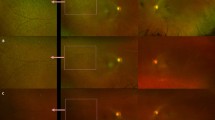Abstract
Hypovitaminosis A is associated with exocrine pancreatic insufficiency in cystic fibrosis. Peripheral retinal dysfunction is an early finding of vitamin A deficiency. We evaluated serum retinol and zinc as well as visual adaptation in 41 patients with cystic fibrosis, receiving generous pancreatic enzyme and micronutrient supplementation. Forty-one normal individuals matched for age and sex served as controls. Peripheral retinal function was measured by clinical electroretinography using an Electrophysiologic Personal Interfaced Computer and applying a standard protocol. Serum retinol in cystic fibrosis was significantly lower than that of the control group (0.30±0.01 versus 0.39±0.02 mg/l, p<0.001). Serum zinc concentrations were normal in the cystic fibrosis group (1.21±0.03 mg/l) and significantly higher than that of the control group (1.02±0.01 mg/l, p<0.001). The overall visual adaptation, however, was found to be normal and comparable in the two groups. It is concluded that, in cystic fibrosis, despite appropriate vitamin A supplementation, retinol serum concentration may be low. As serum retinol does not reflect vitamin A status, evaluation of visual adaptation may be a more appropriate way to monitor for vitamin A deficiency in cystic fibrosis.
Similar content being viewed by others
References
Congden PJ, Bruce G, Rothburn MM, Clarke PC, Littlewood JM, Kelleher J et al. Vitamin status in treated patients with cystic fibrosis. Arch Dis Child 1981; 56: 708–14.
O'Donnell M, Tabot JF. Vitamin A deficiency in treated cystic fibrosis: a case report. Br J Ophthalmol 1987; 71(10): 787–90.
Rayner RJ, Tyrrell JC, Hiller EJ, Marenah C, Neugebauer MA, Vernon SA et al. Night blindness and conjunctiva xerosis caused by vitamin A deficiency in patients with cystic fibrosis. Arch Dis Child 1989; (64): 1151–6.
Huet F, Semama D, Maingueneau C, Charavel A, Nivelon JL. Vitamin A deficiency and nocturnal vision in teenagers with cystic fibrosis. Eur J Pediatr 1997; 156(12): 949–51.
Feranchak AP, Sontag MK, Wagener JS, Hammond KB, Accurso FJ, Sokol RJ. Prospective, long-term study of fat-soluble vitamin status in children with cystic fibrosis identified by newborn screen. J Pediatr 1999; 135: 601–10.
Suttle CM, Harding GFA. The VEP and ERG in a young infant with cystic fibrosis. Doc Ophthalmol 1998; 95: 63–71.
Christian P, West KP Jr. Interactions between zinc and vitamin A: an update. Am J Clin Nutr 1998; 68(2 Suppl): 435–41.
Roels OA, Trout M. Vitamin A and carotene. In: Cooper GR and Kings JS, eds. Standard methods of clinical chemistry. New York and London: Academic Press, 1972; 7: 215–30.
Ros-Bullon Mr, Sanchez-Pedreno P, Martinez-Liarte JH. Serum zinc levels are increased in melanoma patients. Melanoma Res 1998; 8(3): 273–77.
Marmor MF, Zrenner E. Standard for clinical electroretinography. Doc Ophthalmol 1999; 97: 143–56.
Peachey NS, Alexander KR, Fishman GA. Visual adaptation and the cone flicker electroretinogram. Invest Ophthalmol Vis Sci 1991; 32(5): 1517–22.
Rather K, Zrenner E. Factors that influence the increase in the electroretinogram 30-Hz flicker amplitude during light adaptation. Ger J Ophthalmol 1996; 5(5): 286–8.
Neugebauer MA, Vernon SA, Brimlow G, Tyrrell JC, Hiller EJ, Marenah C. Nyctalopia and conjunctiva xerosis indicating vitamin A deficiency in cystic fibrosis. Eye 1989; 3(Pt3): 360–4.
Sheppard JD, Orenstein DM, Chao CC, Butala S, Kowalski RP. The ocular surface in cystic fibrosis. Ophthalmology 1989; 96(11): 1624–30.
Morkenberg JC, Edmund C, Prause JU, Lanng S, Koch C, Michaelsen KF. Ocular findings in cystic fibrosis patients receiving vitamin A supplementation. Graefes Arch Clin Exp Ophthalmol 1995; 233(11): 709–13.
Herrera MG. Vitamin A deficiency: Prevention and treatment. International Seminars in Pediatric Gastroenterology and Nutrition 1995; (4): 2–8
Traber Mg, Diamond SR, Lane JC, Brody RI, Kayden HJ. Beta-carotene transport in human lipoproteins. Comparisons with a-tocopherol. Lipids 1994; 29(10): 665–9.
Lindlblad A, Diczfalusy U, Hultcrantz R, Thorell A, Strandvik B. Vitamin A concentrations in the liver decrease with age in patients with cystic fibrosis. J Pediatr Gastroenterol Nutr 1997; 24(3): 264–70.
Jacob RA, Sandstead HH, Solomons NW, Rieger C, Rothberg R. Zinc status and vitamin A transport in cystic fibrosis. Am J Clin Nutr 1978; 31(4): 638–44.
Krebs N, Sontag M, Accurso F, Hambidge KM. Low plasma zinc concentrations in young infants with cystic fibrosis. J Pediatr 1998; 133: 761–4.
Easley D, Krebs N, Jefferson M, Miller L, Erskine J, Accurso F et al. Effect of pancreatic enzyme on zinc absorption in cystic fibrosis. J Pediatr Gastroenterol Nutr 1998; 26(2): 136–9.
Safai-Kutti S, Selin E, Larsson E, Jagenburg R, Denfors I, Sten G et al. Zinc therapy in children with cystic fibrosis. Beitr Infusionsther 1991; 27: 104–14.
Lepage G, Paradis K, Lacaille F et al. Ursodeoxycholic acid improves the hepatic metabolism of essential fatty acids and retinol in children with cystic fibrosis. J Pediatr 1997; 130(1): 52–8.
Underwood BA, Denning CR. Blood and liver concentrations of vitamins A and E in children with cystic fibrosis of the pancreas. Pediatr Res 1972; 6: 26–31.
Griewe-Crandell KM, Kronfield DS, Gay LA, Sklan D. Seasonal vitamin A depletion in grazing horses is assessed better by the relative dose response test than serum retinal concentration. J Nutr 1995; 125: 2711–6.
Olson JA, Tanumihardjo SA. Evaluation of vitamin A status. Am J Clin Nutr 1998; 67: 148–52.
Friedrich W. Vitamins. Hawthorne, New York: Walter de Gruyter and Co. 1988.
Zak T. Vitamin A deficiency and dark adaptation in children. J Pediatr Gastroenterol Nutr 1982; 1: 467–8.
Perlman I, Barzilai D, Haim T, Schramek A. Night vision in a case of vitamin A deficiency due to malabsorption. Br J Ophthalmol 1983; 67: 37–42.
Lequire LE, Pappa KS, Kachmer ML, Rogers GL, Bremer DL. Loss of contrast sensitivity in cystic fibrosis. Am J Ophthalmol 1991; 111(4): 427–9.
Eid NS, Shroemaker LR, Samiae TD. Vitamin A in Cystic fibrosis: Case Report and Review of the Literature. J Pediatr Gastroenterol Nutr 1990; 10(2): 265–9.
Author information
Authors and Affiliations
Rights and permissions
About this article
Cite this article
Tsinopoulos, I., Nousia-Arvanitakis, S., Galli-Tsinopoulou, A. et al. Role of electroretinography in the assessment of retinal function as an indicator of vitamin A status. Doc Ophthalmol 101, 211–221 (2000). https://doi.org/10.1023/A:1002793728087
Issue Date:
DOI: https://doi.org/10.1023/A:1002793728087




